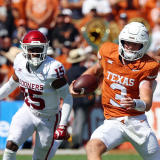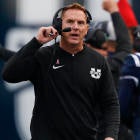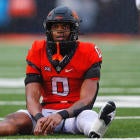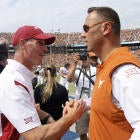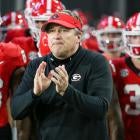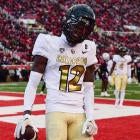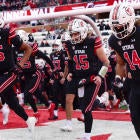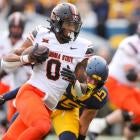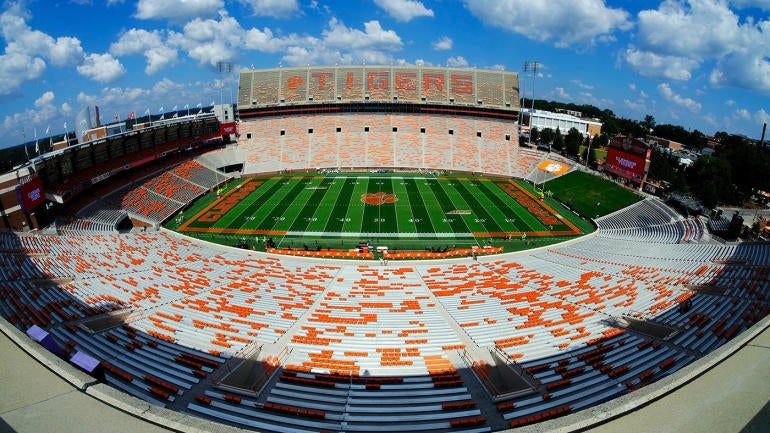
From the beginning of the coronavirus crisis, fingers everywhere in college football have been crossed. While intentions to overcome the global pandemic are noble, the approach and methods are -- pardon the pun -- largely untested.
That's why, without a vaccine, college football continues to dodge raindrops. But did anyone think a thunderstorm would hit so quickly? The count is now 100-plus positives among college players across the nation.
That's the count since June 1 when the NCAA allowed voluntary workouts to begin. And that's only the ones the schools have chosen to tell us about.
Eyebrows and concern were both elevated over the last week as Clemson announced 23 positives, Kansas State suspended voluntary workouts for two weeks after 13 positives, Houston halted activities after six positives and it was reported that also LSU has 30 or more players in quarantine.
That's what has happened on empty campuses in the dead of summer. What's going to be the case if 10s of thousands of students are allowed to descend on these campuses for summer sessions and the fall semester? What about when players actually start swapping sweat and hitting each other in practice?
"That's the big, bright line we're all going to have to step over -- that of non-social distancing. Sports by their very nature, for the most part, don't have social distancing," said TCU athletic director Jeremiah Donati.
College sports is at a unique crossroads of commerce, medicine, ethics and athletics. The stated goal is absolute safety for the athletes. But at the same time, athletic departments desperately need those players to perform in order to access some share of the TV rights revenue in a coronavirus-impacted season.
The players want to play, but they are becoming more self-aware by the day. Their work and sweat props up those budgets, and they can't collectively bargain their working conditions. They can't play in a bubble, like the pros, thereby limiting travel and centralizing medical care.
In many ways, it is a 100-yard dash toward a pile of cash, all while hoping no one gets hurt. Meanwhile, COVID-19 cases have spiked in 29 states with football hotbeds of Florida and Texas considered new hotspots for the virus.
"The healthiest teams are going to be the ones that are going to be there at the end, have the chance to win the most games and play for the biggest prizes," Donati said.
Students being students, they will go to parties, bars and classes. Players can sign all the waivers and pledges they want. The still-developing brain of the typical college student may overrule precautions.
"It's going to be the same thing that happens when you see a bunch of people go to the beach or go to protest rallies," one Power Five AD said. "We're going to find out something."
Yeah, but what? Administrators and health professionals are doing their best to shoehorn in a season amid a pandemic. But they are doing so with the most physical, most intimate game in existence.
As the rash of positives were reported, philosophies have emerged.
"One of those two things has got to happen," that same Power Five AD said, "we'll either get medical advancement … or people have to get to the mindset they don't jump every time they see a case count."
Another veteran Power Five AD chimed in: "This is the type of situation, at this point, we're going to have to create contingencies as best we can. We'll just adjust. The chances of delaying or disrupting seem to be increasing."
It might take a lot more than these early positives to stop a sport that, financially, is of desperate need to play. Contrast that with an overarching question barely three weeks into June: Did college football return too soon?
After all, the NFLPA just advised its players to stop training together amid a spike in cases.
"I think it was a good idea [to return]. I stand by that," Donati said. "Maybe long-term it will benefit them to go through this panic moment. This is new for everybody. As of I now, I think it was a wise move. Take the Band-Aid off. If not, everybody goes home. If you do that, it may set us back."
College football cannot endure a setback. The pandemic has shown the thin financial cliff college athletics teeters on. The mere cancellation of the NCAA Tournament caused an economic upheaval in college sports. With less than two dozen FBS athletic departments actually turning a profit, that was crippling.
Any alteration to the football season would shred the bottom line. The sport accounts for 80% of major-college athletic budgets.
Ohio State as a university has already projected a $300 million loss for fiscal 2020. Notre Dame is projecting to lose $100 million.
Football remains the front porch of major universities. Any damage to that brand is going to have a ripple effect beyond athletics. There has been speculation that entire institutions may shutter if there is no football this season.
Minus a vaccine, the complete enterprise seems to hinge on those fingers being crossed.
"The virus is in more control of this situation than we are," Oklahoma AD Joe Castiglione.
The Sooners deserve special recognition in this discussion. They decided long ago not to open up for voluntary workouts until July 1. That is among the latest starting dates in the country.
Coach Lincoln Riley said it was "ridiculous" to open up facilities June 1. That statement looks prescient with cases on the rise in the state.
"The minimal amount of gains that they would have in that 30-day period, the risks far outweighed the gains," Castiglione said of football activities. "We're not standing in judgement to anyone else. We are not saying, since we made our decision, we're better than anyone else."
One Power Five athletic medical professional expressed his frustration over the weekend as the rash of positives piled up.
"I'm at a loss to even know what to say or do," he said.
"Do we shut down for another month? Do we cancel the full season?
"If we don't have a season, how many of these guys will drop out of school because the only reason they are in classes is to play football?"
Texas on Sunday hit a record number of hospitalizations (3,409) for the 10th day in a row. Florida had more than 4,000 new cases on both Saturday and Sunday, marking rises for four straight days. Arizona has almost doubled its number of cases in the last two weeks to 50,000. At one point earlier this month, its infection rate was three times higher than New York state.
This is a discussion beyond whether the coronavirus' national impact has declined. Every one of these football programs is a microclimate subject to the conduct of players and school policies.
"It's the hours they are away from us that causes that greatest concern," Castiglione said. "They're good friends; they're teammates. They have friends in other sports. It's part of what happens when we all bring people back together."
But is it more than just a rash of positives to be concerned about? As college football passes into July and further into an unknown, an unspoken fear is now being spoken.
"Will we have a death or someone become so sick that they can't play any longer?" that Power
Five medical professional said. "Is one death OK, not two?"


